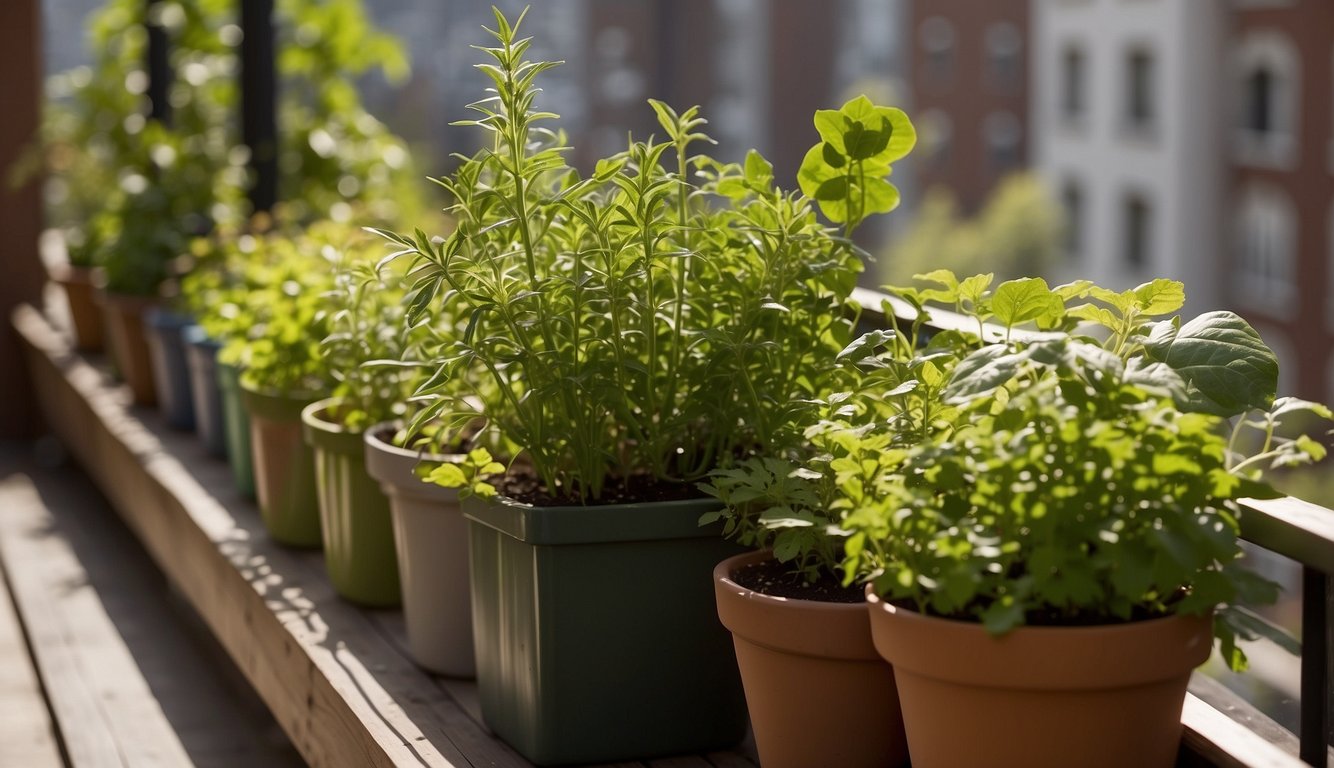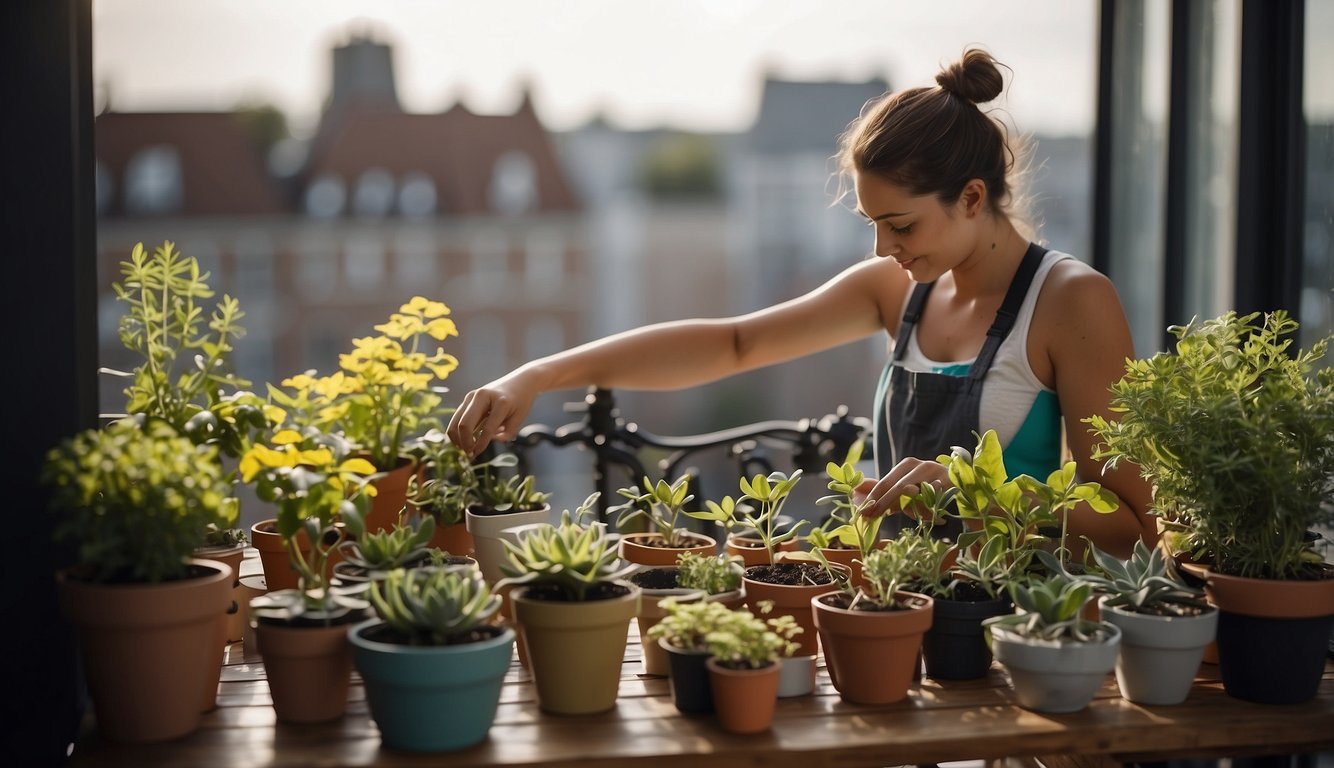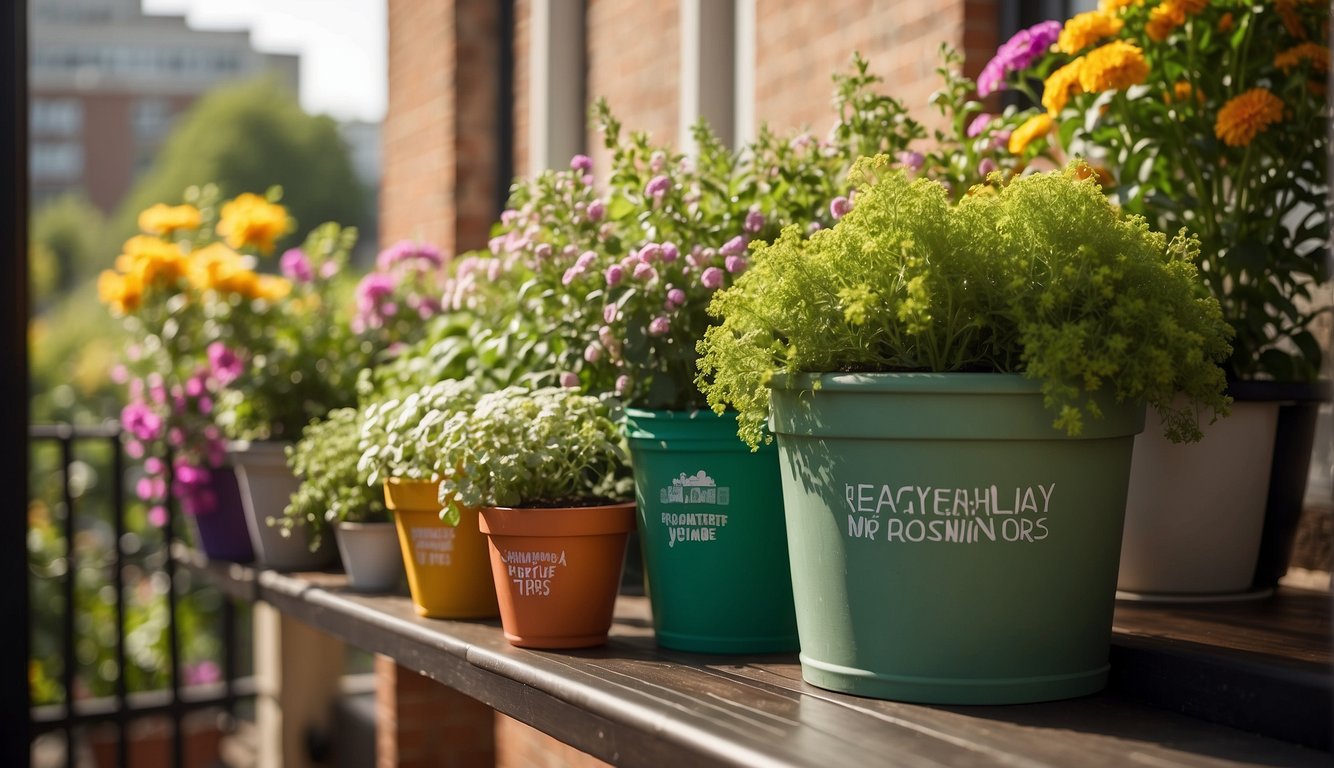Balcony container gardening is an excellent way to bring fresh produce and greenery into your home. Whether you live in an apartment, condo, or have limited outdoor space, balcony gardening can be a rewarding experience. With the right planning, care, and attention, you can grow a variety of plants and herbs in containers on your balcony.

Planning your balcony garden is the first step to success. Consider the amount of sunlight your balcony receives, the size of your containers, and the types of plants you want to grow. Selecting the right containers is also crucial for the health and growth of your plants. Choosing the right soil and fertilizers, as well as proper watering techniques, can also help your plants thrive. Enhancing the aesthetics and functionality of your balcony garden can also make it a beautiful and relaxing space.
Table of Contents
Key Takeaways
- Planning is crucial for a successful balcony garden.
- Choosing the right containers, soil, and fertilizers is important for plant health.
- Enhancing the aesthetics and functionality of your balcony garden can make it a beautiful and relaxing space.
Planning Your Balcony Garden
When it comes to balcony container gardening, planning is crucial. We need to consider a few important factors before starting our balcony garden. Limited space is one of the main challenges we face when it comes to balcony gardening. Therefore, we need to make the most of the space we have. One way to do this is by utilizing vertical space. We can use hanging baskets, wall planters, and trellises to maximize the space available to us.
Another factor to consider is sunlight. We need to choose plants that are suitable for the amount of sunlight our balcony receives. Some plants require full sun, while others can thrive in partial shade. We also need to be aware of the microclimate on our balcony. The microclimate is the unique climate conditions that exist in a specific area, such as our balcony. It can be affected by factors such as wind, shade, and the surrounding buildings. We need to choose plants that are suitable for our microclimate.
When planning our balcony garden, we also need to consider the type of containers we will use. We can use a variety of containers, including pots, troughs, and hanging baskets. We need to choose containers that are suitable for the plants we want to grow. For example, plants with deep roots require deep containers.
Finally, we need to think about our balcony garden ideas. What plants do we want to grow? Do we want to grow herbs, vegetables, or flowers? We need to choose plants that are suitable for container gardening and that will thrive in our microclimate. We can also consider adding accessories such as garden ornaments or lighting to enhance the look of our balcony garden.
By taking the time to plan our balcony garden, we can create a beautiful and productive space that will provide us with fresh produce, beautiful flowers, and a relaxing outdoor space to enjoy.
Selecting the Right Containers

When it comes to balcony container gardening, selecting the right containers is crucial for the health and growth of your plants. We recommend considering the following factors when choosing containers for your balcony garden:
Materials
Containers come in a variety of materials, including plastic, terracotta, and ceramic pots. Plastic containers are lightweight, durable, and affordable. Terracotta pots are porous, providing good drainage and allowing air to circulate around the roots of your plants. Ceramic pots are heavier and more fragile, but they are also more decorative.
Types of Containers
You can use a variety of containers for your balcony garden, including pots, window boxes, hanging baskets, and grow bags. Pots are the most common and versatile type of container. Window boxes can be attached to the railing of your balcony, providing a beautiful display of flowers and herbs. Hanging baskets are perfect for trailing plants, while grow bags are ideal for vegetables and fruits.
Drainage Essentials
Good drainage is essential for the health of your plants. Make sure your containers have drainage holes at the bottom to allow excess water to escape. You can also add a layer of gravel or stones to the bottom of your containers to improve drainage.
Choosing Containers
When choosing containers for your balcony garden, consider the following:
Size and Depth: Choose containers that are deep enough to accommodate the roots of your plants. The size of your container will depend on the size of your balcony and the number of plants you want to grow.
Color: Consider the color of your container when choosing plants. Dark-colored containers absorb more heat, which can be harmful to some plants.
Weight: Keep in mind that containers can be heavy, especially when filled with soil and plants. Make sure your balcony can support the weight of your containers.
By considering these factors, you can select the right containers for your balcony garden and create a thriving, beautiful space to enjoy.
Choosing Plants and Arrangement
When it comes to balcony container gardening, choosing the right plants and arranging them correctly is key to success. We want to ensure that our plants thrive in their container environment, and that they look beautiful too. Here are some tips for selecting and arranging plants for your balcony container garden:
Consider Your Space and Climate
Before selecting plants for your balcony, consider the amount of space you have and the climate you live in. If you have limited space, select plants that will grow well in small containers or that can be trained to grow vertically. If you live in a hot and dry climate, choose plants that are drought-tolerant and can handle full sun exposure.
Choose the Right Plants
When selecting plants for your balcony container garden, consider the type of plants that will grow well in containers. Vegetables, herbs, and succulents are all great options for container gardening. Edibles like tomatoes, peppers, and strawberries can be grown in containers and can provide a bountiful harvest. Ornamental grasses can add texture and movement to your container garden, while flowers like petunias and marigolds can add color and fragrance.
Mix and Match
Mixing and matching different plants in your container garden can create a beautiful and interesting display. Consider combining plants with different textures, colors, and heights to create a visually appealing arrangement. When choosing plants, make sure they have similar water and light requirements to ensure they thrive together.
Container Garden Design Tips
When designing your container garden, consider the size and shape of your containers. Larger containers can accommodate more plants and can provide more room for root growth. Smaller containers can be used for smaller plants or as accent pieces. Consider using a variety of container sizes and shapes to create interest and depth in your container garden.
Final Thoughts
Choosing the right plants and arranging them correctly is key to a successful balcony container garden. Consider the amount of space you have, the climate you live in, and the type of plants that will grow well in containers. Mix and match different plants to create a visually appealing arrangement, and consider using a variety of container sizes and shapes to create depth and interest.
Caring for Your Balcony Garden
When it comes to caring for your balcony garden, there are a few key things to keep in mind. In this section, we will cover watering and fertilizing, managing sunlight and temperature, and pest control and maintenance.
Watering and Fertilizing
Watering and fertilizing are two of the most important aspects of caring for your balcony garden. When it comes to watering, it’s important to choose the right soil and watering method. We recommend using a high-quality potting soil, such as one that contains peat moss, perlite, or coco coir. These materials help to retain moisture and provide good drainage.
To water your plants, you can use a watering can or a drip irrigation system. Self-watering pots are also a great option, as they help to regulate the moisture levels in the soil. When it comes to fertilizing, we recommend using a slow-release fertilizer that is specifically designed for container gardens. Be sure to follow the manufacturer’s instructions carefully, as over-fertilizing can be harmful to your plants.
Managing Sunlight and Temperature
Sunlight and temperature are also important factors to consider when caring for your balcony garden. Be sure to choose plants that are suited to the amount of sunlight and heat that your balcony receives. Some plants require full sun, while others prefer partial shade. If your balcony gets very hot, you may need to provide some shade for your plants to prevent them from wilting.
You can also use shade cloth or other materials to help regulate the temperature on your balcony. It’s important to monitor the light conditions and temperature regularly to ensure that your plants are thriving.
Pest Control and Maintenance
Finally, pest control and maintenance are important aspects of caring for your balcony garden. Be sure to inspect your plants regularly for signs of pests or disease. If you notice any issues, take action immediately to prevent them from spreading.
Regular maintenance, such as pruning, deadheading, and removing dead leaves, can also help to keep your balcony garden healthy and vibrant. Be sure to follow the specific care instructions for each type of plant to ensure that they are getting the care they need.
By following these tips for caring for your balcony garden, you can ensure that your plants thrive and provide you with beautiful, fresh produce all season long.
Enhancing Aesthetics and Functionality
When it comes to balcony container gardening, enhancing the aesthetics and functionality of your space is just as important as growing healthy plants. In fact, incorporating decor and functional elements can elevate the overall ambiance of your balcony garden and create an inviting outdoor oasis.
One way to enhance the aesthetic appeal of your balcony garden is by incorporating decor pieces that complement your plant selection. For example, rattan chairs and foldable tables are both stylish and weather-resistant, making them a great choice for outdoor furniture. Additionally, adding trellises or other vertical gardening structures can help create a more visually appealing and interesting space.
Another way to enhance the functionality of your balcony garden is by incorporating hanging baskets, hanging planters, or shelves to maximize space. This is especially important if you have a small balcony or limited floor space. However, it’s important to consider the weight of your plants and decor when choosing these types of functional elements to ensure they are safe and won’t damage your balcony.
In addition to decor and functional elements, privacy is also an important consideration for balcony container gardening. Incorporating tall plants or using trellises to create a natural barrier can help create a more private and intimate space.
Overall, enhancing the aesthetics and functionality of your balcony container garden is a great way to create a trendy and inviting outdoor space. By incorporating decor, functional elements, and privacy considerations, you can create a beautiful and functional garden that you can enjoy year-round.
Conclusion
In conclusion, balcony container gardening is a fun and creative way to bring the beauty of nature to your small living space. With the right balance of plant varieties and proper care, even a small balcony garden can provide ample sources of homegrown goodness.
When selecting plants for your balcony garden, consider a variety of textures and colors to add visual interest to your space. Mixing different plant heights and shapes can also create a dynamic and interesting garden design.
Remember to keep your balcony garden well-maintained, with regular watering and pruning to ensure your plants stay healthy and vibrant. Incorporating a variety of plant species can also help to promote biodiversity and support local ecosystems.
Overall, balcony container gardening is a rewarding and fulfilling hobby that allows us to connect with nature and bring a little bit of greenery into our daily lives.
Frequently Asked Questions

What are the best plants to start with for a beginner’s balcony container garden?
When starting a balcony container garden, it’s important to choose plants that are easy to grow and maintain. Some great options for beginners include herbs like basil, parsley, and thyme, as well as vegetables like cherry tomatoes, lettuce, and peppers. Flowers like petunias, marigolds, and pansies are also easy to grow and add color to your balcony garden.
How can I maximize space in my small balcony for gardening?
Space is often a constraint when it comes to balcony gardening. However, there are several ways to maximize the space you have. Vertical gardening is one option, where you can use trellises or hanging baskets to grow plants vertically. You can also use stackable planters or tiered shelving to create more planting space. Another option is to use window boxes or railing planters to add more greenery to your balcony.
What is the ideal soil mix for container plants in balcony gardens?
Choosing the right soil mix is essential for the success of your balcony garden. A good soil mix should be well-draining, nutrient-rich, and have good water retention. You can create your own soil mix by combining equal parts of peat moss, vermiculite, and perlite. Alternatively, you can purchase pre-made potting soil mixes that are specifically designed for container plants.
How often should I water my balcony garden containers?
The frequency of watering your balcony garden containers depends on several factors like the type of plant, the size of the container, and the weather conditions. As a general rule, you should water your plants when the top inch of soil feels dry to the touch. Overwatering can lead to root rot, so it’s important to ensure proper drainage in your containers.
What are some creative DIY container ideas for balcony gardening?
Container gardening is not just limited to traditional pots and planters. You can get creative with your container choices and upcycle items like old buckets, mason jars, or even shoes! Just make sure that your container has proper drainage and is large enough to accommodate the plant you want to grow.
How can I protect my balcony container garden from pests and harsh weather?
Pests like aphids, mealybugs, and spider mites can be a problem in balcony gardens. You can protect your plants by regularly inspecting them for signs of infestation and using natural pest control methods like neem oil or insecticidal soap. To protect your plants from harsh weather conditions like strong winds or heavy rain, you can use shade cloth or row covers to provide some protection.


